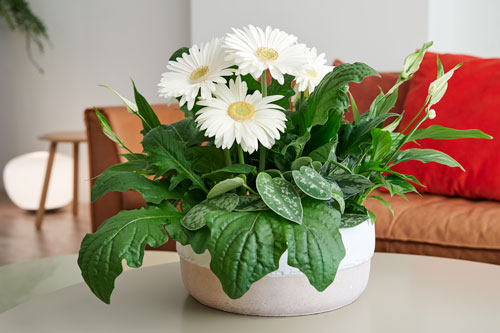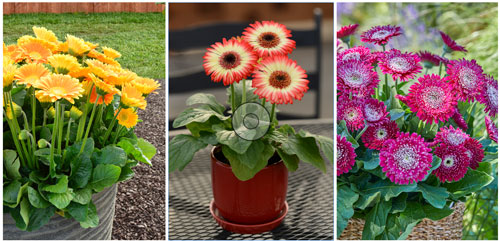1/1/2024
Why Gerberas Got Game
Lowell Halvorson

The heart of the gerbera market in North America rests on indoor potted plants and, toward warmer markets, outdoor potted plants and garden beds. Sometimes gift products include gerberas, but most often consumers take them home as decoration. The common denominator is color impulse. Gerberas offer a quick hit of garden goodness that adds little rays of sunshine to your day. Just charming.
Pictured: Flori Line Giants have expansive blooms with leaves to match.
Uniformity sits as a high priority. A manufacturing-style crop production aims for consistency across high volumes, well presented for retail. More and more, gerberas sell into distribution channels that prefer packaged goods, like grocery stores and home improvement centers. These places know how to drive color impulse purchases.
Gerberas know how to trigger an impulse purchase—the key is balance. Those big cabbagey leaves get vigorous if pushed and scrawny if starved. Big plants tend to fill big pots better, but overgrown small pots too fast. For a cell in a tray, you need a seed that produces a different plant. Up and down the pot sizes, gerberas like to work this way because the thick leaves emerge from rosettes. Knitting them together can be done, but it’s harder to keep under control.
This level of fine-tuning spawns massive series. A good example is the Flori Line series from HilverdaFlorist, built up over three decades and driven by the huge European appetite for potted plants. Seventy-seven color choices are spread across five different size classes: Giant, Maxi, Midi, Mini and Micro. I haven’t worked with a bigger series.
Selecting the socket
Approach gerberas like a large socket set. Hover over the collection as if you have a rachet in your hand, and pick out the size and shape that works for your pots. Once you’ve picked your tray—the Midi, say—look up and down for the solids or two-tones you want to use. Consider Fireball and Eye Catcher Purple, two of the most popular colors.
The same technique works for PanAmerican’s named series. They organize by size: Mega Revolution, Revolution and ColorBloom. That last series specializes in the small sizes. ColorBloom’s foliage holds its tips closer to the crown, keeping them distinct and separate in the tray. Plants also have more flower buds that open with overlapping petals to keep the tops feeling substantial within a small tray space. Pick ColorBloom Watermelon with Dark Eye or Bicolor Orange Yellow as good examples of what this series can do.
 Pictured: Garvinea Sweets hold the classic singles for outdoor work. • Revolutions have some bold bicolors in their lineup. • Garvinea Majestics are the doubles for landscapes.
Pictured: Garvinea Sweets hold the classic singles for outdoor work. • Revolutions have some bold bicolors in their lineup. • Garvinea Majestics are the doubles for landscapes.
Gerbera’s popularity has spread its cheerfulness into landscaping venues. This work requires a tougher, more substantial series, so turn to a series like Garvinea. If you work with landscapers, carry this one. Garvineas handle temperatures down to frost, but, importantly, they continue their color through the high heat of summer rather than cycling in and out of it. This series is also rated a perennial at Zone 7, so some locations can keep their displays year after year. Again, Garvineas have three trays to work with: the Sweets are classic singles in solids; the Majestics are the double versions; and the Cheekies are unusual mini-bloom/maxi-count versions that mimic what violas do in the pansy market.
The importance of pose
Though the sweet spot seems to be the quart size, sales spread across the full range from six-packs to specimens in 10-in. pots. Each region has its favorite sizes. Gerbera’s willingness to follow the protocol predictably makes pot-matching easier, to improve “The Pose” of the product. Habit is a plant’s natural shape, but The Pose is that moment when a crop is at retail prime and looking its best. The more heavy lifting the seed can do, the less grooming the plant needs, the less expensive the crop becomes and the better the sell-through at point of purchase. This is why the socket nature of these expansive gerbera series benefit mass channels of sales.
Pricing also factors into gerbera’s mass adoption. Expensive seed is seed that folds right into existing production schemes as a premium product. Innovations like seed coating make it more compatible with automated machinery, improving the aim for the center of the pot. Coatings also increase the speed of the line, decreasing the unit cost.
As seen in other genera, closing the blooming window is a priority among breeders. Most talk about tightening the shipping window to clear out a house quicker. Different series have different windows, but the windows are tightening.
Finding the look
Bear in mind that each series creates The Pose in the house style of their breeders. Jumping tiers keeps the same pose, but sizes it up or down. Jumping series gives your product a different pose. For example, PanAmerican products adopt a fuller, rounder shape, whereas Syngenta’s Jaguar series aims to show off the silhouette of a runway model. Jaguar focuses on the blooms and thick stems that emphasize the cut flower heritage gerberas first earned in the floral market.
For extra-big gerbera flowers, turn to the Patio series. Flowers can span 6 in. across and they have an undercarriage to match. If you need to cover a wide pot with a single plant, look here. Patio has both solids and two-tones in their color mix, plus there’s a companion series of extra-fuzzy doubles called Patio Glorious.
If you need a complete socket set of doubles, turn to the Sundayz series. Available in three sizes, this series has a full mix of white eye, dark eye, solids and two-tones to rummage. A very unusual bloom is Midi Berries ’n Cream, a white with a double strip of red around the eye. GT
Lowell Halvorson is a consultant and writer in Fairfield, Connecticut, for retail and wholesale horticulture, specializing in business development. He also covers the breeding community for GrowerTalks magazine. You can contact him at (203) 257-9345 or halvorson@triadicon.com.